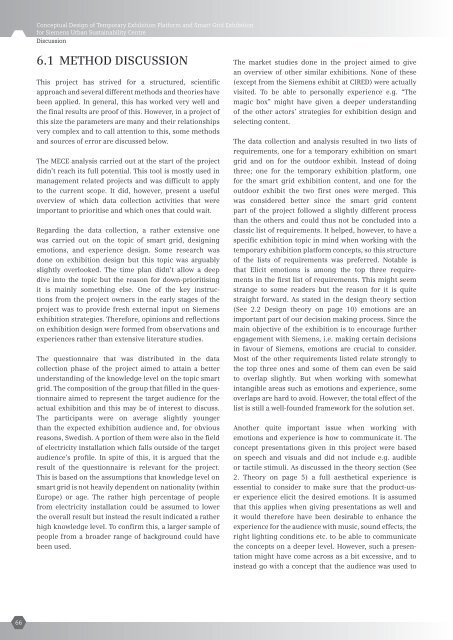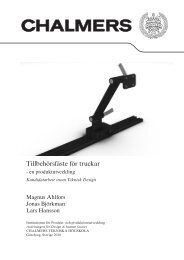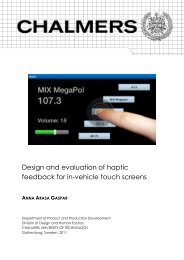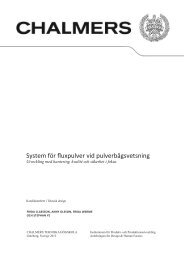Thesis - Teknisk Design
Thesis - Teknisk Design
Thesis - Teknisk Design
- No tags were found...
You also want an ePaper? Increase the reach of your titles
YUMPU automatically turns print PDFs into web optimized ePapers that Google loves.
Conceptual <strong>Design</strong> of Temporary Exhibition Platform and Smart Grid Exhibitionfor Siemens Urban Sustainability CentreDiscussion6.1 Method discussionThis project has strived for a structured, scientificapproach and several different methods and theories havebeen applied. In general, this has worked very well andthe final results are proof of this. However, in a project ofthis size the parameters are many and their relationshipsvery complex and to call attention to this, some methodsand sources of error are discussed below.The MECE analysis carried out at the start of the projectdidn’t reach its full potential. This tool is mostly used inmanagement related projects and was difficult to applyto the current scope. It did, however, present a usefuloverview of which data collection activities that wereimportant to prioritise and which ones that could wait.Regarding the data collection, a rather extensive onewas carried out on the topic of smart grid, designingemotions, and experience design. Some research wasdone on exhibition design but this topic was arguablyslightly overlooked. The time plan didn’t allow a deepdive into the topic but the reason for down-prioritisingit is mainly something else. One of the key instructionsfrom the project owners in the early stages of theproject was to provide fresh external input on Siemensexhibition strategies. Therefore, opinions and reflectionson exhibition design were formed from observations andexperiences rather than extensive literature studies.The questionnaire that was distributed in the datacollection phase of the project aimed to attain a betterunderstanding of the knowledge level on the topic smartgrid. The composition of the group that filled in the questionnaireaimed to represent the target audience for theactual exhibition and this may be of interest to discuss.The participants were on average slightly youngerthan the expected exhibition audience and, for obviousreasons, Swedish. A portion of them were also in the fieldof electricity installation which falls outside of the targetaudience’s profile. In spite of this, it is argued that theresult of the questionnaire is relevant for the project.This is based on the assumptions that knowledge level onsmart grid is not heavily dependent on nationality (withinEurope) or age. The rather high percentage of peoplefrom electricity installation could be assumed to lowerthe overall result but instead the result indicated a ratherhigh knowledge level. To confirm this, a larger sample ofpeople from a broader range of background could havebeen used.The market studies done in the project aimed to givean overview of other similar exhibitions. None of these(except from the Siemens exhibit at CIRED) were actuallyvisited. To be able to personally experience e.g. “Themagic box” might have given a deeper understandingof the other actors’ strategies for exhibition design andselecting content.The data collection and analysis resulted in two lists ofrequirements, one for a temporary exhibition on smartgrid and on for the outdoor exhibit. Instead of doingthree; one for the temporary exhibition platform, onefor the smart grid exhibition content, and one for theoutdoor exhibit the two first ones were merged. Thiswas considered better since the smart grid contentpart of the project followed a slightly different processthan the others and could thus not be concluded into aclassic list of requirements. It helped, however, to have aspecific exhibition topic in mind when working with thetemporary exhibition platform concepts, so this structureof the lists of requirements was preferred. Notable isthat Elicit emotions is among the top three requirementsin the first list of requirements. This might seemstrange to some readers but the reason for it is quitestraight forward. As stated in the design theory section(See 2.2 <strong>Design</strong> theory on page 10) emotions are animportant part of our decision making process. Since themain objective of the exhibition is to encourage furtherengagement with Siemens, i.e. making certain decisionsin favour of Siemens, emotions are crucial to consider.Most of the other requirements listed relate strongly tothe top three ones and some of them can even be saidto overlap slightly. But when working with somewhatintangible areas such as emotions and experience, someoverlaps are hard to avoid. However, the total effect of thelist is still a well-founded framework for the solution set.Another quite important issue when working withemotions and experience is how to communicate it. Theconcept presentations given in this project were basedon speech and visuals and did not include e.g. audibleor tactile stimuli. As discussed in the theory section (See2. Theory on page 5) a full aesthetical experience isessential to consider to make sure that the product-userexperience elicit the desired emotions. It is assumedthat this applies when giving presentations as well andit would therefore have been desirable to enhance theexperience for the audience with music, sound effects, theright lighting conditions etc. to be able to communicatethe concepts on a deeper level. However, such a presentationmight have come across as a bit excessive, and toinstead go with a concept that the audience was used to66
















